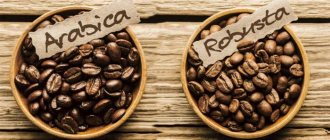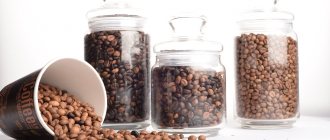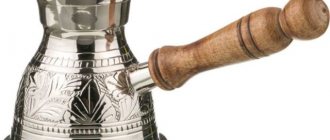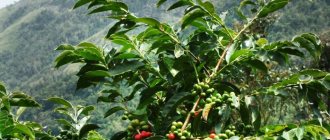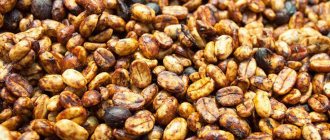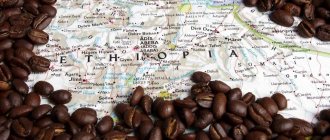Where does Arabica grow?
Arabica grows mainly, like other coffee trees, in an equatorial climate, at an altitude of 600 to 2500 meters above sea level, at a temperature of 15 to 24 degrees.
The coffee tree blooms and bears fruit all year round, for 50 years, especially the first 15 years. Moreover, the number of harvests directly depends on the climate, for example in the mountains, where it is drier and cooler to harvest one crop, and in warm and humid valleys, up to 4 times a year. Typically, within a year, one Arabica coffee tree produces 5 kg. berries, from which about 1 kg is obtained. ready grains. Just think about how much work this is.
Chemical composition of grains
The chemical composition of grains is determined by their species. It determines the taste, aroma, benefits and harms of a coffee drink.
Arabica beans contain half the caffeine content. This reduces their tonic properties. They contain more sucrose and less chlorogenic acid.
The drink brewed from them has a soft, rich, pleasant taste. It also contains more esters that determine aromatic properties. Therefore, this coffee has a rich aroma.
The table will clearly demonstrate the differences in the composition of natural coffee of both varieties.
| Component | Arabica | Robusta |
| Ethers | 18% | 8% |
| Sugar | 8% | 4% |
| Chlorogenic acid | 6,5% | 9% |
| Caffeine | 1–1,5% | 3% |
Arabica bean shape
Russian people like to buy “with their eyes” and when they see a large coffee bean, they believe that they need to choose it, it is the most delicious. This life hack is not always correct; when choosing olives, yes, but not for coffee. For example, we roast more than 15 types of Arabica from different parts of the planet, and they are all different in shape and size: Ethiopia Yirgacheffe is quite small, Nicaragua Maragogipe is huge, and Brazil Santos is something in between. And all these are Arabica, and they are united by an oblong-oval shape. A little later, speaking about varieties of Arabica, we will understand why this happened in nature. By the way, our full range of Arabica beans can be found in the corresponding section.
How Arabica is used and what it does in coffee
We can say that Arabica is the most important type of coffee on the planet, since its share in world production is about 70%. The uses of Arabica are different, below we will look at three main areas, and also talk about the purposes for which it is used:
- In espresso blends. If robusta is added to mixtures to increase the density, bitterness and strength of the drink, then arabica gives the blend acidity and a variety of unique aromas due to the higher content of essential oils.
- In single-origin coffees. This is for those who like to taste coffee in its “pure form”, from a specific country, region, plantation, where it grew.
- For instant and flavored coffee. In both cases, they almost always take the cheapest coffee.
General properties
Modern scientific research has shown that coffee activates the brain , prevents the development of senile dementia, and has a positive effect on the body's blood vessels. Arabica and Robusta are the same:
- Stimulates mental activity.
- Prevents Alzheimer's disease.
- Strengthens the cardiovascular system by widening and narrowing the arteries.
- They have a diuretic effect and cleanse the body.
- They promote weight loss as they accelerate the breakdown of fats.
These qualities manifest themselves only with dosed, moderate consumption of the drink. Also, both varieties have their own aroma, bitterness and sourness, contain caffeine, sugar, essential oils and other elements.
Varieties (varieties) of Arabica
First of all, it is worth understanding how a variety of Arabica can appear. Basically there are two ways:
- Natural. This is either a natural crossing, which is how Arabica appeared, or a natural mutation, which is how bourbon and maragogip appeared, which we will talk about later.
- Artificial. If with the natural method everything is clear, nature does its job, then with the artificial one it is man who takes part. Its goal is “on the surface”: to develop a new variety of coffee tree that will be productive, susceptible to parasites and, most importantly, produce delicious coffee. This method is called selection.
It is also very important to understand that the genetic base of coffee is quite poor, since long ago, only one variety of Arabica, Typica, went on a trip around the world. And today, the bulk of world Arabica production relies on about 25 varieties, mostly derived from evolutions of that same type. Now, we will talk about the most famous representatives of Arabica:
- Bourbon is the first noticed natural mutation of Typica, which was discovered on the island of Reunion, the then name was Bourbon, hence the nickname. Basically, the historical logic behind the name of coffee largely depended on the location in which the coffee tree with the new mutation was discovered.
- Caturra - this mutation was discovered in Brazil in the mid-20th century. The new tree turned out to be more productive than typica and bourbon, and also lower, which made it easier to pick berries. Soon, Caturra spread throughout the American continent, pushing Typica and Bourbon into the mix.
- Maragogyp – This coffee is very popular, especially in stores. It is called “elephant grain” and is bought with “the eyes”. It appeared in the Brazilian state of Bahia, near the city of Maragohipi
There are about 120 other varieties of coffee: Liberica, Geisha, Rume Sudan, Timor, Moka, Catuai, Blue Mountain, Sln 32 and others. If you are interested in “dig” deeper, then the article “Types and varieties of coffee | What are they and how many of them exist” will help with this. See you soon.
Helpful information
Without this naturally invigorating drink, many of the adult population of the planet cannot imagine starting the day. Chatting over a cup of coffee is a great way to lift your spirits. Real coffee lovers prefer to drink a natural drink prepared in a coffee machine or Turkish coffee machine. No instant or, even worse, coffee drink!
Story
Many people have heard about such coffee varieties as Arabica, Robusta, Liberica. The most famous is Arabica. Until the 20th century, only this variety was known throughout the world. Originating from Ethiopia, the coffee tree has the scientific name Coffea arabica. This variety has been known since VI and was also grown in Yemen. The tree grows at altitudes of up to 2000 m, on volcanic and mountain slopes. Plain coffee is believed to contain more caffeine.
After the rainy season, the coffee tree begins to bloom, and it takes 9 months for the fruits to ripen. Therefore, there can be flowers and fruits on a tree at the same time. This circumstance forces you to harvest by hand so as not to damage the flowers. For example, in Brazil, special tools are used for collecting, with the help of which coffee fruits are shaken from the trees onto the ground.
After this, they are raked and cleared of debris. Coffee productivity is low; only 1 kg of fruit can be harvested from one tree. Trees do not tolerate low temperatures and are very susceptible to pests. To destroy them, various drugs are used, this increases the cost of cultivation, which leads to an increase in the price of the final product. As a result of selection, more resistant specimens were obtained.
The taste of the final drink is affected by the processing and transportation of raw materials. For example, after long-term transportation in hot weather, taste qualities may change for the worse. Therefore, the proximity of a seaport also affects the quality characteristics of coffee.
The number of types of Arabica reaches five dozen.
Main types of Arabica
The taste of different types of coffee depends on climatic conditions, collection and subsequent processing of beans.
- The Bourbon variety is most similar to the world's first, grown in Ethiopia more than 1,000 years ago. The name of the species is derived from its place of origin - Bourbon Island (now French Reunion). The best varieties of Latin America come from this species. Yellow bourbon grows high in the mountains of southeastern Brazil. The variety is not subjected to any crossing; its fruits have a thin shell, which helps the grains dry directly on the branches. Ripe grains have a yellowish tint - this is reflected in the name. The variety is considered the best, has a balanced and rich taste.
- Half of all coffee grown in Brazil is Bourbon Santos, the standard of coffee taste. The drink has a delicate chocolate aftertaste. During the first 4 years, the trees produce very small fruits, but the coffee from them is of very high quality with a mild aroma. Several subspecies of Arabica are grown in Brazil. This type has a small grain size with a high percentage of caffeine and a nutty flavor.
- Jamaica Blue Mountain - elite and expensive. Plantations cover the slopes of the Blue Mountains of Jamaica. Coffee has a mild taste with the aroma of rum, which comes from the fact that, according to tradition, the beans are usually transported in wooden barrels from this drink. This variety is especially popular in Japan. 80% of the harvest is supplied to this country.
- Nepal Everest Organic is rare and exclusive. A coffee tree plantation appeared in Nepal in 1994, and favorable conditions were created for them. The drink has a tart taste with sourness and a nutty flavor.
- Kopi Luwak is a very expensive, unique coffee. It is grown in Indonesia, as well as on the islands of Java and Sumatra. The prepared coffee has a unique caramel aroma with chocolate notes. What is unusual is the way the grains are processed. They pass through the stomach of local animals, luwak, and are treated with civet. Animals select fruits of one ripeness and eat them, then they come out naturally.
- Coffee trees are grown on the island of Sumatra, the fruits of which are distinguished by their strength and aroma. The smell has a tartness and a bready taste. The grains are processed in the open air using a dry method, and the shell is cleaned by hand.
- In Kenya, on the slopes of Kilimanjaro, ideal conditions have been created for the cultivation of premium grains. The taste depends on the degree of roasting, so it is usually sold green so that everyone can get their own taste.
- In Ethiopia, two types are noted: Yorgachef with a delicate aftertaste and winey aroma and Harar with a taste that depends on the place of cultivation and storage method; it can be fruity or spicy.
- The oldest variety of mocha coffee grows in the mountains of Yemen. This is an elite species and is in great demand, although the grains themselves are small and broken.
- An elite type of Arabica grows in Hawaii, one of the popular premium classes.
- In Peru, in the Andes, fruits are grown that are labeled “organic”; no chemicals are added to the soil. The drink has a light aroma with fruity notes.
- In Zambia, Arabica beans of the Lupeli variety are harvested, with caramel, bitter orange, and herbal flavors.
The vast majority of coffee beans on sale are a mixture of varieties with 80% Arabica content. 100% has a delicate taste with sourness due to the low caffeine content.
Benefits of Arabica
Arabica accounts for 70% of the total coffee exports. Why is this variety more popular than Robusta? Here are the main points:
- Bright, refined taste with different aromas, depending on the place of growth;
- Low caffeine content;
- The bitterness is not pronounced;
- The drink has a long sweet, nutty aftertaste.
The two main varieties differ in their cultivation methods. Robusta is considered a wild variety because it does not require special care. Arabica requires human participation in the process of ripening and harvesting. Coffee trees of this variety grow at altitudes of up to 2000 m, while Robusta grows in the lowlands, their tree height is up to 6.5 m, while Arabica coffee trees grow up to 4.5 m high.
Arabica beans have an oval shape, while Robusta has smaller, round fruits.
When choosing Arabica beans you need to pay attention to:
- to the country of origin;
- what aromas accompany the prepared drink.
For example, African Arabica has a multifaceted taste: tropical fruits, grapes, spices, caramel. To maximize the taste of coffee, it is necessary to brew freshly roasted beans, and it is advisable to purchase it from the manufacturer, and not from the supermarket.
About storage and degree of roasting
For long shelf life, it is recommended to use green grains. Without treatment, this coffee can be stored for up to 2 years. Exposure to temperature accelerates chemical processes.
Caffeine levels and the release of essential oils are affected by the degree of roasting. There are 5 steps:
- light or Scandinavian;
- average;
- medium dark;
- dark;
- strong.
